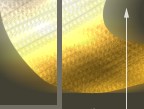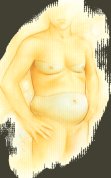



Procedures
See the Photo Gallery
Call to request information or schedule a consultation: Contact Us
Gynecomastia /
Liposuction 
Liposuction, known technically as lipoplasty, liposculpture or suction lipectomy, is a procedure that can help sculpt the body by removing unwanted fat from between the skin and muscle. Depending on the individual patient, lipoplasty may result in dramatic changes in your silhouette by contouring and defining specific body areas. The most commonly treated areas in women are the abdomen, hips, buttocks, thighs, knees, upper arms, chin, cheeks and neck. In men, the love handles, abdomen, breasts, neck and chin are most common.
 The surgery can be
performed in our office. We are fully accredited by the
American
Association for Accreditation of Ambulatory Surgical Facilities.
Our operating room and recovery rooms are separate from the rest
of the office and therefore provide you with both privacy and
convenience. During the surgery, Dr. Shienbaum is assisted
by a Certified Nurse Anesthetist who will use IV sedation for
your anesthesia. You are given medication in your IV that
allows you to fall asleep and remember very little. There
are no gases to inhale and you are breathing on your own.
The surgery can be
performed in our office. We are fully accredited by the
American
Association for Accreditation of Ambulatory Surgical Facilities.
Our operating room and recovery rooms are separate from the rest
of the office and therefore provide you with both privacy and
convenience. During the surgery, Dr. Shienbaum is assisted
by a Certified Nurse Anesthetist who will use IV sedation for
your anesthesia. You are given medication in your IV that
allows you to fall asleep and remember very little. There
are no gases to inhale and you are breathing on your own.
Significant improvements in liposuction technology have occurred during the last ten years. One, the tumescent technique, is routinely used and favored by Dr. Shienbaum, providing more precise results and a speedier recovery. Although liposuction is not a substitute for proper dieting and exercise, it can remove stubborn areas of fat that refuse to respond to traditional weight loss methods.
You must have realistic expectations about what liposuction can do for you. While the procedure can enhance your appearance and help boost self confidence, it wont necessarily alter your appearance to match an ideal or unrealistic body shape. You should seriously consider what you want to achieve, identify your expectations, and discuss these with Dr. Shienbaum.
While there is no weight limit for liposuction the best candidates are people with firm, elastic skin who experience pockets of excess fat in certain areas. Age also is not a major factor; however, you should understand that older patients may have reduced skin elasticity and may not achieve the same results as a younger patient with tighter skin.
The doctor is highly trained in and routinely employs the tumescent technique for liposuction. This technique is considered the safest form of liposuction for removing large amounts of fat because there is minimal blood loss. In this technique, Dr. Shienbaum will inject a small amount of local anesthetic. This numbs the area and reduces bleeding, bruising, and swelling.
There is a limit on the amount of fat that can be removed during a procedure. Removal of the fat cells involves use of a micro small tube called a cannula which is connected to the suction machine. The cannula is inserted through very small incisions which are inconspicuous. Fat removal is accomplished as the cannula creates tiny tunnels through the fatty layer. The tunnels collapse following removal of the fat.
As with any surgical procedure, liposuction has certain common side effects, such as bruising, swelling, and temporary numbness. Although irregularities of the skin are possible, this is minimized by use of the micro cannula.
Dr. Shienbaum and his staff at Brandon Plastic Surgery welcome you to a complementary initial consultation during which your desires and expectations will be discussed. A medical history will be taken and the doctor will examine you and provide his recommendations. The staff will provide you with the opportunity to view photos of previous patients so that you may better comprehend likely results, information about the facility where your surgery will be performed, and appropriate expenses.
If you decide to proceed the staff will work with you to arrange a surgery date, answer your questions and take photos. The doctor uses an advanced digital imagery camera. The staff will also provide you with presurgery instructions, including guidance on eating, drinking, smoking and the taking or avoidance of certain medications and vitamins. You will need to arrange for someone to pick you up after surgery and stay with you for at least 24 hours.
The type of anesthesia you will receive will provide the safest and most effective level of comfort. The time required to perform the surgery varies. A compression garment will be needed after surgery to insure proper healing and minimalization of skin irregularities.
Once the surgery is complete, a bandage is applied and you are transferred to the recovery room. After about 1 1/2 hours you have a chance to wake up good from the anesthesia. Then, the nurse will help you dress and take you out to your family member or friend who is waiting to pick you up. She will explain what care you will require at home. The first night after your surgery, our office will call you and talk with either you or your caregiver to make sure you are doing well and do not have any questions.
You will likely feel groggy and sore the first 24 hours and you should expect some swelling and discomfort. You will be seen the day following your surgery in the office. You can expect to be up and around in 24 to 48 hours. Most discomfort will be controlled with medication. Healing is a gradual process and you should start walking as soon as possible to reduce swelling. Most patients are pleased with how quickly they are able to return to normal activities.
The new body contour should emerge as swelling subsides.
Frequently asked questions:
1. Will the fat grow back? Liposuction involves the permanent removal of fat cells. Not all fat cells are removed. Therefore, fat cells remaining can eventually grow. Ensuring a healthy diet and exercise will prevent growth.
2. How much fat can you remove? The amount removed depends on the individual. You will be evaluated during your complementary consultation. Make sure the doctor is fully aware of your medical history. The treatment is not for obesity.
3. What risk categories may prevent me from having surgery? People with diabetes, heart or lung disease, or poor blood circulation are at increased risk.
813-681-5709
Home
~~ Contact
Us ~~
Practice Info
~~ Dr.
Shienbaum ~~
Photo Gallery








